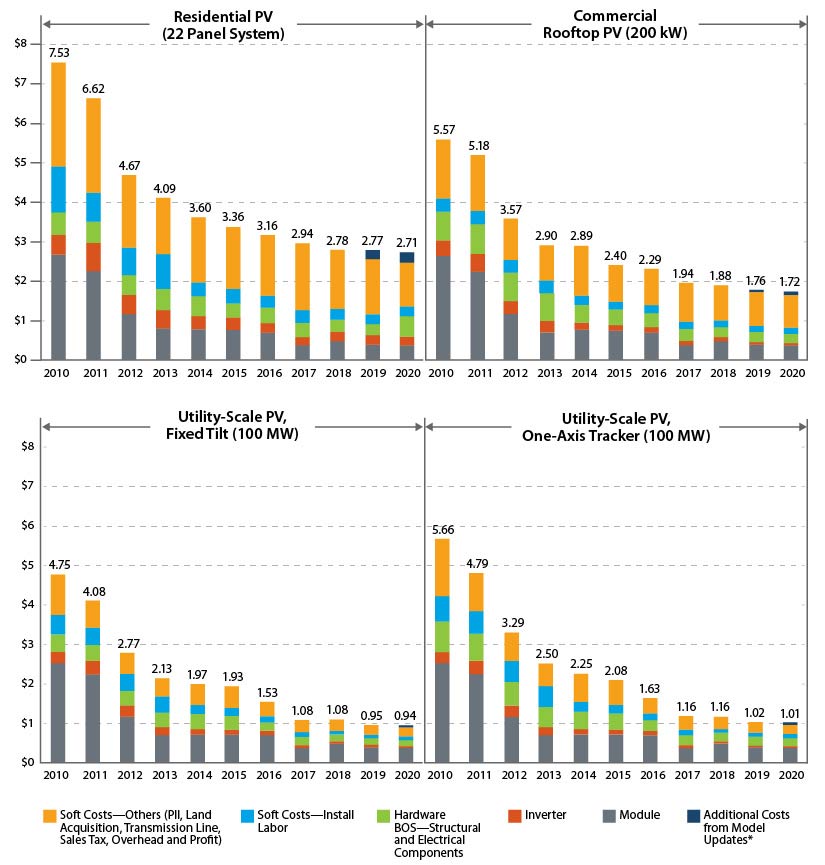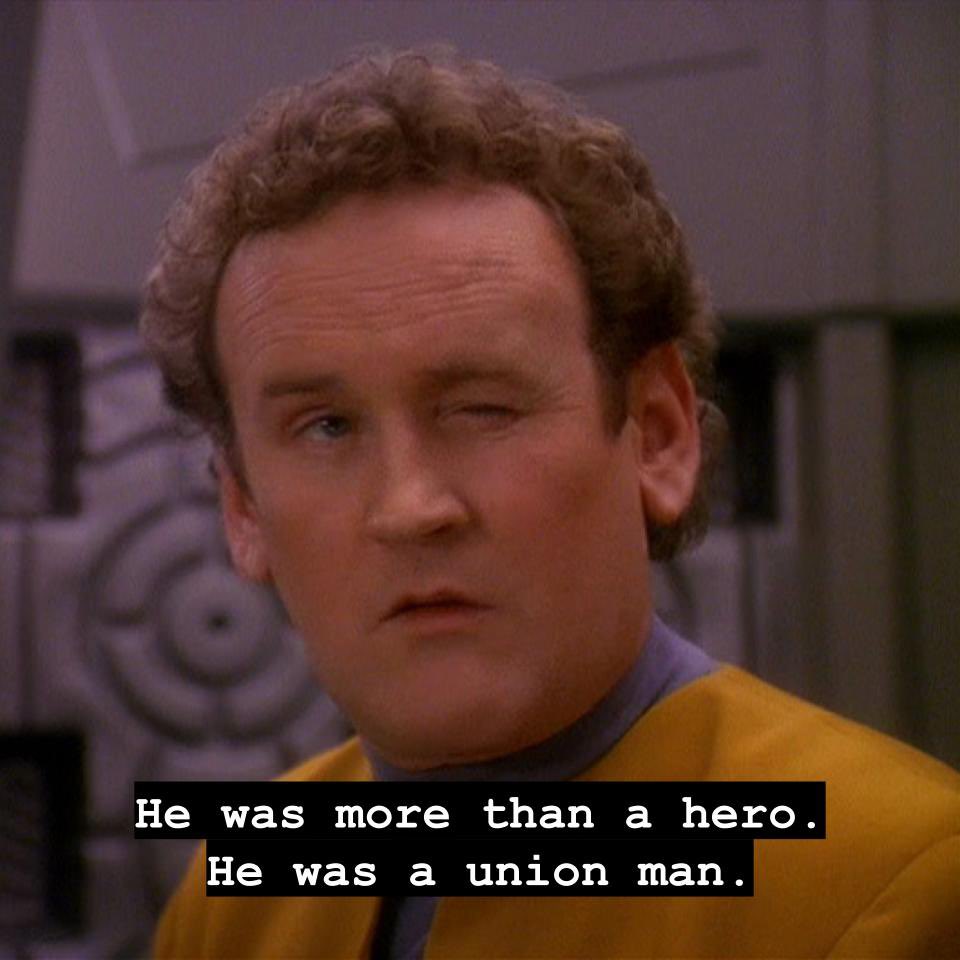Solar now being the cheapest energy source made its rounds on Lemmy some weeks ago, if I remember correctly. I just found this graphic and felt it was worth sharing independently.
Imagine how steep that line would be if the fossil fuel lobbies hadn’t been fighting it tooth and nail all these years
much more important: we’d be years ahead with storage technology.
I could be wrong but I don’t think there’s any evidence that the fossil fuel industry worked to suppress storage research/funding. Pretty much every IT industry has a huge interest in improving battery tech and energy storage in general, it’s just that we’ve already hit all the low hanging fruit from a chemistry standpoint
I remember hearing stories about oil companies buying up battery patents. But this may be because they want to collect the royalties, not necessarily to suppress any kind of research. But like you said, I don’t think there is any evidence… But if they were suppressing the technology, we probably would never know about it.
My dad was a VP at an oil major and has a literal story of an LNG tech being bought and shelved. Yet he’s still just like the people he complains about in that story. They’re a strange generation, these boomers.
Gotta keep prices high yo
It would be less steep because solar costs would have come down earlier.
That would make it steeper, no?
This part of the graph (2009-2019) would be less steep, because this sharp drop would have happened earlier - we’d be further along the curve
Without saying anything about politics, environment, or source:
Why, for the love of Satan, does this graph have only 2 data points per source?
Why use a line chart 📉 for that?
This is clear bar chart territory 📊.
I know it’s not ideal, but a bar chart design could either focus on the difference over time for each source, or the difference between sources at each time. This plot gives a good representation of both the differences between sources and the change in time for each source. It really drives home how far solar prices have fallen relative to other sources and in absolute terms.
It’s called a slope chart and it has several benefits compared to bar charts:
- https://datavizproject.com/data-type/slope-chart/
- https://seeingdata.org/taketime/inside-the-chart-slope-graph/
- https://www.storytellingwithdata.com/blog/2020/7/27/what-is-a-slopegraph
I for one think this is much better than using a bar chart for this use case, as the angled arrows make it immediately obvious the information that matters the most here (the rate of change) while still keeping it contextualized (by relative initial positions). The bar chart version of this would inevitably look more cluttered and would not be more effective in conveying the incredible progress in solar costs.
The cost of the panels themselves doesn’t seem to have gone down nearly that much.

OP’s data is LCOE, which takes into account much more than $/MW. Rather importantly, expected operating liftetime is a major component (and historically THE major economic downside of PV).
IIRC, LCOE is calculated for utility-scale solar, which has seen a 500% decrease according to your chart.
Finally, Neither chart specifies, but if OP’s is in constant dollars and yours isn’t that would explain a lot as well.
Dang, it’s almost like it was worth all the research money the government crammed into it in the long run, unlike what my dad said to me a million times.
Sweet, now get the panels and installation cheaper so I can afford to put it on my house
Further lowering panel cost isn’t going to significantly cut that price. Cost of labor is the major part of that.
People always focus on rooftop solar, but it’s horribly expensive compared to a field of panels. The economics of scale will almost certainly keep it that way.
Wouldn’t that be a less sustainable use of land?
I guess maybe not if we are talking tall building, where the roof surface area may not be sufficient for the entire building. But it would be a waste not to make use of all the unused rooftops
Yeah, in some countries, land is at a premium. No way would it be wasted on just solar panels. Rooftop installations make the most sense.
They are even testing putting them afloat on dam reservoirs.
I’ve always thought that in the neighborhoods where everyone lives in townhomes and mini apartments a shared multi floor parkade with solar and maybe also wind on top should be a thing. Even if the solar is just covering the parkade’s power usage.
We had a solar salesman come by once and told us he could lower our electricity bill the same amount as it would cost us to install the solar panels.
I knew there was something up with this but I decided to let him continue to talk anyways. He does this whole presentation with solar panels and how great they are for a good 30 minutes.
Finally we get to the money part and he keeps emphasizing that they will lower my electricity bill so the cost of them will be made up there. I push him for the total cost of them plus installation and I about died.
$30,000??? They literally wanted me to pay for these for 30 years. As long as my mortgage! Aaaaah!!!
I had a few come over and I was already in the market for solar so I entertained them for a minute. I told them “OK, give me some invoices for your other customers so I know what you charge. Black out the names, I dont care - I just want the prices of your services and materials”. These idiots would not stop calling me or coming over to my house for months. I kept telling them “Unless you give me actual, real world dollar amounts, I won’t consider it”.
Those solar sales guys are worse than used car salesmen.
That’s about 10 times the price it costs to have a full system installed in other parts of the USA.
I put in a small solar backup power system myself for $1500. It’s not enough to power HVAC or any big appliances but it is enough that I can have my fridge, freezer, TV, and Internet going off the grid whenever there’s a power outage.
Some companies in my area are installing them for free, and taking the utility difference. It’s a novel approach.
Just to save $100 a month.
1001230
But they will still have to make the monthly payments for the solar panels. So, their real savings will only start after they paid off the loan in 30 years. lol
If I save 100$ a month, sign me up
The installation just keeps getting higher. Now to add onto mine I need a load of additional equipment that was not required when my first lot of enphase inverters was installed. Also what was quoted for the labour and materials that are not the panels and inverters has almost tripled in 4 years. Have to get the roof sorted before I go ahead with it and the higher output panels and inverters mean that I would get about another 1.5kw in the same space compared to my first installation.
Rooftop solar is the most expensive way to do it. The graph above is for utility scale systems. Roofs are always custom jobs and they’re priced accordingly. Utility scale uses racks that are all the same for an entire field.
If rooftop was priced alone on the chart in OP, it’s be around the price of nuclear.
To ballpark some numbers on the contractor side, I charge about $100/hr to install it now - 4 years ago that might have been $60/hr.
I just installed a 9.3 kW system with individual microinverters under each panel for grid stability and it is absolutely amazing how much you can power all day without threatening a massive bill at the end of the month. I still import power at night, but the power companies usually have agreements where you get credits for all wattage exported to the grid to cover your imported power at night, because both parties win in that contract.
Do you mind sharing what price one can expect for an install that size (or similar)? I’ve been wanting to install a system like that on my house for a couple years. Now that prices on hardware are more affordable it’s becoming very tempting. I’d love to do it myself.
deleted by creator
AUS here, I just got a 10kw system installed last month, cost 9.5k AUD for everything. So far monitoring the generation, I’ll be getting paid next time the bill comes around :)
Well, looking at these prices here listed seems like solar in US is really costly for some reason? I have a 9.8kWp system in europe, installed a year or two ago, and it cost me 12k euros. Out of that, I’ll get 2ke back in tax rebates, so 1ke for 1kwp.
During summertime, I get 1500kWh approx in a month. I have one AC unit and two electric cars, and a 24U server rack, and can live without electricity bills some months.
It depends, $180/mo for 25 years is the agreement and it’s directly connected to the grid both ways which required additional work from the power company to inspect and approve. I think given the projections it was rated for about 25,000 kWh per year * 25 years (approaching 85% efficiency after 30 years), which is a good amount of total production for my needs. Edit: it’s worth considering what $180/mo will look like in 5 to 20 years… it will probably be significantly cheaper compared to other power sources because it’s generated locally.
Yes the time value of money can work heavily in your favor when projecting that far out. The way the housing market is right now, I might be here for a while 🤣 Thanks for the response!
Get 800kwh to 1mwh a month depending on sun coverage. Cost me 23k paid in full.
Where are you located and what was the total cost? When I last got quotes 12 years ago, it was insanely expensive ($ 70k ) .
deleted by creator
I hate that PGE got rid of the export.
Is this just the cost per raw Watt produced?
Is it a fair comparison vs conventional fuel-based power (coal/nuclear)?
Ie: if you wanted to build a plant capable of producing continuously, 24 hours a day, you would need some multiple of solar panels to produce an excess during daylight, and storage.
Not that drastic drops in solar costs aren’t bad, just what would the cost-per-watt be if you had to power an average city on just solar for a year?
Look at the subtitle on the chart, it’s levelized cost over the generator’s lifetime. So not including storage for any intermittent source like solar or wind
And not including the financing cost of buying up an this upfront.
I’m buying 36kWh solar array and it will be home made diy, used.parts and maximum jank and don’t paid upfront because that’s the only way it makes economic sense and that’s hoping it works for more than 7 years (break even point at my insolation level and and grid price (8.8$cad/kWh) and it only works with net metering)
In my area, you don’t get any government incentives unless it is professionally installed. They get you coming and going.
Yes, I never even considered the subsidies, I know it’s not for me.
Well you’ll never get a “fair” comparison, because the environmental effects are never properly priced into the consumer price.
It’s frustrating seeing a graph showing the price of electricity going down while my utility prices go up. Does this take into account infrastructure cost?
deleted by creator
Yeah energy prices have gone through the roof but apparently it’s cheaper in every way except nuclear - and we don’t even have nuclear around here
Pretty clearly shows why there’s no future for nuclear power.
Even for filling gaps in renewables, peaker plants are getting cheaper and don’t take 15 years to build.
This is always a weird take to me because it always ignores the fact that nuclear has been screwed continuously for decades. If any other tecbology, renewable energy or not, had the same public and private blockers did it would also have no future.
Nuclear has been screwed by its own track record.
Why do you think it’s had such a wide coalition of public and private opponents?
Well that’s simply false. Its been screwed by ignorance propaganda and fear mongering.
You clearly don’t understand the other side.
Sure buddy. And you clearly do.
Actually I do. I was a nuclear booster in the 1990’s because it means cheap limitless pollution free power.
Except that they don’t actually deliver on that promise. You can have safe nuclear or cheap nuclear, but if it’s safe it’s not cheap, and the public rightfully won’t accept something that can require evacuating hundreds of square miles for decades.
So wise one, where are those cheap safe nuclear power plants we keep hearing about since 1950?
In France. They standardized the designs so each one isn’t a one-off and they trained more people to work in the field.
So the user above me actually gave the the answer so kudos to them but to further answer your question, there are no actually cheap reactors because the fight to actually build one is so insanely expensive. Where I live they’d been trying to build a reactor for over a decade. Constant lawsuits and legal battles after already obtaining permits and everything. Its ballooned the cost by tenfold. Why? Because of constant NGO pressure from the likes of greenpeace. So congrats, you win. They aren’t cheap cause of the hell we’ve made for ourselves.
the other side is big oil
LOL. It’s “big solar” that’s eating their lunch.
yeah but I want the power to work between 4 pm and 8 am
Has there been a scenario where the technology itself is to blame? The contamination aspect of nuclear waste is well known and preventable, if costs are being cut on radioactive waste disposal (or in the case of a certain Japanese power company, ignoring warnings from the government on how to reduce ocean contamination in the event of an earthquake) a nuclear installation’s fate is sealed…
As far as I can see, the only downsides with nuclear IMO is that it takes multiple decades to decommission a single plant, the environmental impact on that plant’s land in the interim, and the initial cost to build the plant.
In comparison to Solar it sounds awful, but before solar, nuclear honestly would have made a lot of sense. I think it may even still be worth it in places that have a high demand for constant power generation, since Solar only generates while the sun’s about, and then you’re looking at overnight energy storage with lithium-based batteries, which have their own environmental and humanitarian challenges
Uranium powered fission technology, not all nuclear. Look into Thorium
“Today there are about 440 nuclear power reactors operating in 32 countries plus Taiwan, with a combined capacity of about 390 GWe. In 2022 these provided 2545 TWh, about 10% of the world’s electricity.”
There have been two major reactor accidents in the history of civil nuclear power – Chernobyl and Fukushima Daiichi. Chernobyl involved an intense fire without provision for containment, and Fukushima Daiichi severely tested the containment, allowing some release of radioactivity.
Yes- a track record of one plant failing due to Soviet incompetence and political blunders; and the second failing due to checks notes a 9.0 magnitude almost direct earthquake and ensuing 133 ft tsunami.
you mean the part where it generated a shit ton of carbon free reliable power while killing fewer people per watt-hour what any other method? with outdated 60’s technology too? yeah sure sounds like a failure
This.
And it is always a question how they calculated handling of nuclear waste.
There are options, we can use coal and natural gas for on demand power to fill the gaps in renewables, we don’t have to quit all at once. New ideas for energy storage and comming around, some of them might be useful for small towns, others for remote places.
deleted by creator
indeed. when you kill nuclear, the reality is natural gas and sometimes coal is the real replacement
nuclear waste, by definition of being radioactive, is the only wast that goes away on it’s own if you leave it sit for long enough
I was considering whether this is just a shitpost, but your other comments suggest that you’re completely serious. It does not go away. Radioactive decay causes multiple transitions between radioactive elements until it ends up as lead, which does not decay further.
Of course, it should also be said that it’s better to have no waste than waste that eventually turns into lead.
And that it’s still better to have waste than waste which also happens to be toxic.
I think that’s too simplistic of a view. Part of the high cost of nuclear is because of the somewhat niche use. As with everything, economies of scale makes things cheaper. Supporting one nuclear plant with specialized labor, parts, fuel, etc is much more expensive then supporting 100 plants, per Watt.
I can’t say more plants would drastically reduce costs. But it would definitely help.
The source article actually talks about this and measured data suggests nuclear cost actually went up, despite more capacity being built.
This is the first time, I’ve read this anywhere. More sources/studies would be really important. And there is lots of interpretations to be had on the why, but assuming the article isn’t completely off the mark, that’s cold, hard data suggesting that your (perfectly reasonable) assumption is actually wrong, after all.
Interesting, I’ll have to look at the source article.
But as far as I’m aware the total amount of nuclear power has been decreasing in recent years. This might change with China’s future plants.
I’ve also read about small modular reactor designs gaining traction, which would help alleviate the heavy costs of one off plants we currently design and build.
Not saying the source is wrong, just saying that’s what I used to form my opinion.
china’s been building dozens of reactors, all of a common design which is the correct way https://en.wikipedia.org/wiki/Hualong_One
bullshit regulatory costs can increase infinitely without nay change to the underlying engineering or economics. that’s 100% the cause of the price increses
Possible. But well, whether these regulations actually are bullshit or not, kind of doesn’t matter. A dumb solar panel won’t ever need to be regulated as much. If that’s what makes it cheaper, it still is cheaper.
They’ve had 75 years to get the cost down. It’s still going up.
because of oil funded fear pushing pseudoscience based restrictions
Congratulate yourself then. The propaganda you and your ilk continue to spew is the reason for this.
Oh it’s just the meanies keeping the poor nuclear industry down! 😆
Of course It is, the incompetent and ignorant people that try to hinder it’s use is the problem
The nuclear industry is 100% responsible for the operational record of the nuclear industry.
So the people who built that reactor were incompetent and ignorant?
Reading comprehension isn’t really your strong suit, eh? “The incompetent and ignorant people that try to hinder it’s use is the problem”
If you are hired to do a task and then overrun the budget by 14B$ I wouldn’t exactly call it furthering the cause. More like incompetence and/or trying to detail the project.
the most dangerous part of nuclear power is not using enough
This chart is worthless, so it doesn’t show anything. Like 2 data points for this? Seriously? And there was a pandemic and a war since then…
I wish hydroelectricity was there.
Thanks, China.
And Germany!
Where’s hydro? Because it would be a straight line at the bottom…
This is the price for new plants, so it would be incredibly high at the start with a steady drop for decades.
I want a battery in my house big enough for me to lose power for 2 days and still cook with electric stove and have hot water from water heater.
That is my dream for every house. To be able to have a stable power well from some kind of battery fed by a solar + grid sharing. To be able to offer extra power to a neighbor if they need it for a project or a party or help however.
I don’t want to be energy isolated from the grid. I want to be energy insulated and be of the grid.
Just pointing out that the grid is paid for by your electric bill, roughly half of what you pay is for delivery (paying to maintain the equipment needed to deliver you that energy), the other half is for supply (paying the power plant that generated the energy). So even if you and all your neighbors are energy independent you’ll still be on the hook for at least half your bill, or they’ll have to recoup it in taxes or something.
Not saying that’s a bad thing, just clarifying a common misconception that going solar should not mean you eliminate your electric bill. In fact many places where solar does offset 100% of your electric bill are ending up with the rich owning solar and the poor paying to maintain the grid for them.
Hydrogen is the answer for that, cost about 100k today hopefully those cost will decline fast
There is this vision for the future, where people can use the battery in their electric car (or a separately bought battery) to store power, either produced by their own cheap solar or from the grid during over-production. And then some software could sell that energy back into the grid at night or during high demand.
If that becomes a reality, we might have it at least so that if a chunk of the grid gets cut off for a bit, it can actually tide that over.
This isn’t so much a vision for the future, as it’s an option right now.
I can’t wait until work puts in car chargers- Top off the battery for free during the day, come home and sell that juice back to the grid, baby!
The price of electricity produced is an interesting metric to look at but can be very misguiding alone without more data around it.
It like comparing the price of rain water compared to well water.
The same way that solar is cheaper than nuclear, rain water is much cheaper than well water, you just need a roof with a gutter to get rain water.
Does it means that we should stop using wells and rely only on rain water and use water only when it rains ? Or do we also want to have tanks, do we need a backup for when the tanks are empty ? …
Yeah, there may be situations/regions where even the cheapest solar isn’t good enough. But at some point, the cost difference does become an oppressive argument. Even at that price in 2019 already, you can use around 75% of your money to build storage or redundancy in multiple regions / with alternative renewables.
And this trend of cost reduction for solar will very likely continue, even if it might start levelling off at some point.
Government subsidies work for getting new technologies out of the prototype stage and into practical deployment. Solar and wind are both good demonstrations.












